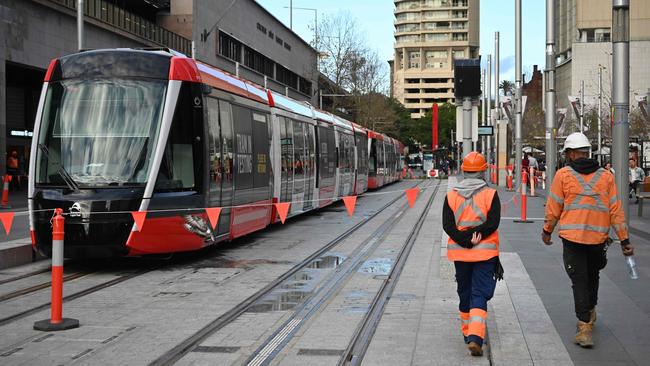Productivity matters and we need to lift it
Improved output takes effort but the payoff is higher living standards.

Australians will have their own views about this year’s federal election result but there can be little doubt it has delivered a climate of unusual political certainty. This throws up a welcome challenge: how do we maximise this period of stability to set the country up for the next wave of prosperity?
For the Business Council of Australia, this centres on improving productivity. It’s time to put misdirected priorities in the rear-view mirror and coalesce around the practical bite-sized measures we can take now to drive higher living standards and increase wages growth.
After all, it is being the productive country — not just the lucky country — that will guarantee Australia can continue to be resilient, competitive and punch above our weight.
But first we must shake off the collective complacency that 28 years of uninterrupted economic growth have given us.
There’s no better wake-up call than the latest round of data from the authoritative Household, Income and Labour Dynamics in Australia survey, which this newspaper rightly devoted serious time and analysis to because it understood what it was telling us about Australia.
The HILDA data illustrates in stark terms what a lack of productivity means for Australians.
The income of middle Australian families, after taking into account taxes and inflation, was lower in 2017 than it was almost a decade ago. Our productivity malaise is largely to blame — and it is forcing Australians to tread water.
In the 1990s, productivity growth ran at an average 2.2 per cent a year. This was also the pace of real income growth. In the 2000s, real income growth ran at about the same rate but slower productivity growth was offset by the record terms of trade. Now the terms of trade boom is over. Productivity growth has been about 1.2 per cent a year since 2010 and real income growth also has slowed to 1.2 per cent.
Productivity matters because it determines whether we can all get ahead. Increasing productivity is about doing everything better. It is not about people working harder for less; it is about people working smarter and more effectively by making the most of every ingredient that goes into producing our goods and services.
Productivity happens when employers have the capacity to invest and innovate in expanding, training workers, updating machinery and adopting new technologies. They’re able to produce, sell and export more, allowing them to employ more workers and pay them more.
It can involve nurses spending more time with patients and less time buried in paperwork, thanks to improved systems and processes. Or it’s nation-building infrastructure that enables goods and produce from regional Australia to journey efficiently into lucrative export markets. It’s investing in innovation, whether that’s developing a medical device, software for accounting or phone apps to book travel.
This is how productivity improvements work in practice: they make our lives better.
Investment is one of the central drivers of productivity but right now business investment as a share of gross domestic product is at its lowest level in 25 years.
Scott Morrison recently called on business to help identify the regulations and bureaucratic barriers that impose “the largest costs on key sectors of the economy” and serve as a hurdle to investment. To get things moving, we need to focus on taking action on the chunks of micro reform we can do now. Done together, they will help drive higher wages and higher living standards.
There are six key priorities to help jolt productivity growth that I will outline in a speech to the Australian British Chamber of Commerce in Perth on Tuesday.
The first is lifting business investment, which fell during the past year. In the absence of a corporate tax cut for all companies, we are proposing a broadbased investment allowance. Say we have a banana grower in Cairns looking to invest in sheds for packing, packaging and grading. The whole fit-out could come to $1 million. While this can be depreciated, with a 10 per cent investment allowance the grower would also get a $100,000 extra deduction this year. That’s money to reinvest into expanding the business or employing more people.
Second, we need to get our infrastructure flowing. An initial step would be the commonwealth and states agreeing on the extent and sequencing of national public infrastructure projects. A strategic and planned pipeline developed from the ground up can deliver what places and communities need.
Third, let’s arm Australians with the skills they need to keep working now and into the future as technology changes. There is much to do in this area but why not start by establishing a single information point for post-secondary education and skills? Students and workers needing to retrain would have the information they need at their fingertips about courses, cost and career prospects.
Fourth, we need a co-ordinated assault on the dead weight of red tape and regulation that is keeping a lid on productivity and acting against job creation. We could begin by scrapping outdated retail trading hours. Shoppers can go online 24-7 to buy anything, anytime, but in Western Australia some shops can sell light bulbs but not light fittings and kitchen sinks but not dishwashers.
On a larger scale, let’s speed up approvals for major projects by repealing appeals by non-impacted third parties under the Environment Protection and Biodiversity Conservation Act.
We agree projects need rigorous and stringent environmental assessment but the system allows a group in Melbourne — that isn’t directly involved or affected — to appeal against a job-creating project in regional Australia and tie it up in the courts.
We have to determine whether the present system is working for all Australians.
Fifth, we need to find a way to get electricity and gas bills down. Our focus should be on an energy mix driven by technological change and innovation that delivers reliable and affordable energy and reduces our emissions. Part of this is opening up the supply of gas, a critical transition fuel for a lower-emissions economy. We have an array of mechanisms, systems, funds and schemes to draw on to achieve these objectives.
And finally, we need to urgently focus on ensuring workplaces operate in the interest of employers, workers and enterprises. Our present system is too rigid and it is too hard to employ people. It cannot go on like this.
We continue to support enterprise agreements as the centrepiece of the relationship between workers and businesses but we want it to work better. Workers on EBAs get paid more. Non-managerial workers earn on average about $13 more an hour than workers on awards, and a little more than 50 per cent of non-managerial workers on EBAs earn more than $1600 a week compared with almost 20 per cent on awards.
But our paper, The State of Enterprise Bargaining in Australia, underscores the problems. We have the lowest number of active federal enterprise agreements in 20 years. Productivity is overwhelmingly at the workplace level. And EBAs are the best tool employers and workers have to figure how to be more productive and then benefit from it.
To get the EBA system working better, we need to unscramble the complexity of EBAs. They have become Downton Abbey-sized laundry lists, containing way too many items. This bogs down negotiations, agreements take too long to conclude, and it stifles the ability of employers and workers to respond to changing circumstances.
We also need to act on the “better off overall” test. BOOT is a productivity killer. As the Productivity Commission found in 2015, the application of BOOT “discourages enterprise bargaining and creates uncertainty during the agreement approval process”.
The test was originally intended to mean that your workforce was better off overall than under the award. In 2016 the Fair Work Commission found the test effectively meant that every individual worker and prospective worker had to be better off than the award.
In practice, to meet every individual circumstance that may arise, an employer may be in the situation where their EBA may need to be better than the award in almost all aspects. In the real world, how is this practical?
If you have a complex workforce that offers flexibility and choice to your workers, you’ll have casual and permanent staff. But casual and permanent staff have different requirements and they trade off different things for different benefits.
Say you are working in a 24-7 environment and your permanent workers want to work on weekends. They trade off their penalty rates for a higher salary overall. But how do you balance this out for casuals who don’t work 35 hours a week? The problem with the way the BOOT is operating is that it prevents trade-offs.
A company that cannot meet demand quickly, cannot rapidly change what it’s doing and is strangled by an inability to make trade-offs is a company that cannot thrive. When it cannot thrive, fewer people are employed and some may lose their jobs.
We support the Productivity Commission’s recommendation of a no-disadvantage test. This does what it says: overall, workers don’t end up disadvantaged compared with the award. It also means that if workers place a higher premium on, say, flexible working conditions than weekend rates, they could trade them off against each other, as long as their cumulative wages and conditions meant they weren’t disadvantaged. We know from history that EBAs have driven higher wages and higher productivity. But right now, the proportion of people working under a federally registered EBA that has lapsed — but is still operational — has climbed during the past four years to almost 40 per cent of federally registered EBAs.
We can’t allow the EBA system to die the death of a thousand cuts. We all want a nation where all Australians can get ahead, sharing in the dividends of prosperity. A more productive society is inherently a fairer society.
Jennifer Westacott is chief executive of the Business Council of Australia.




To join the conversation, please log in. Don't have an account? Register
Join the conversation, you are commenting as Logout